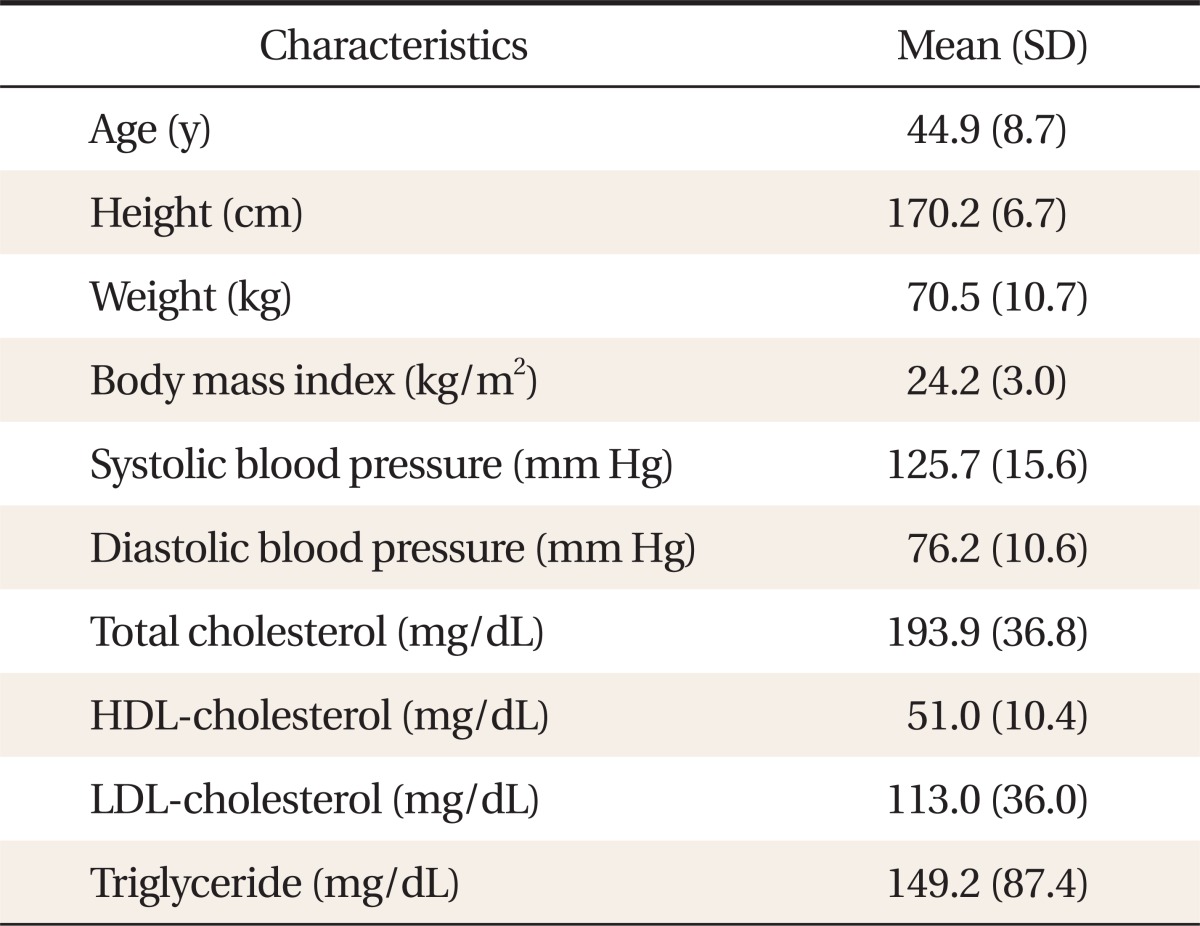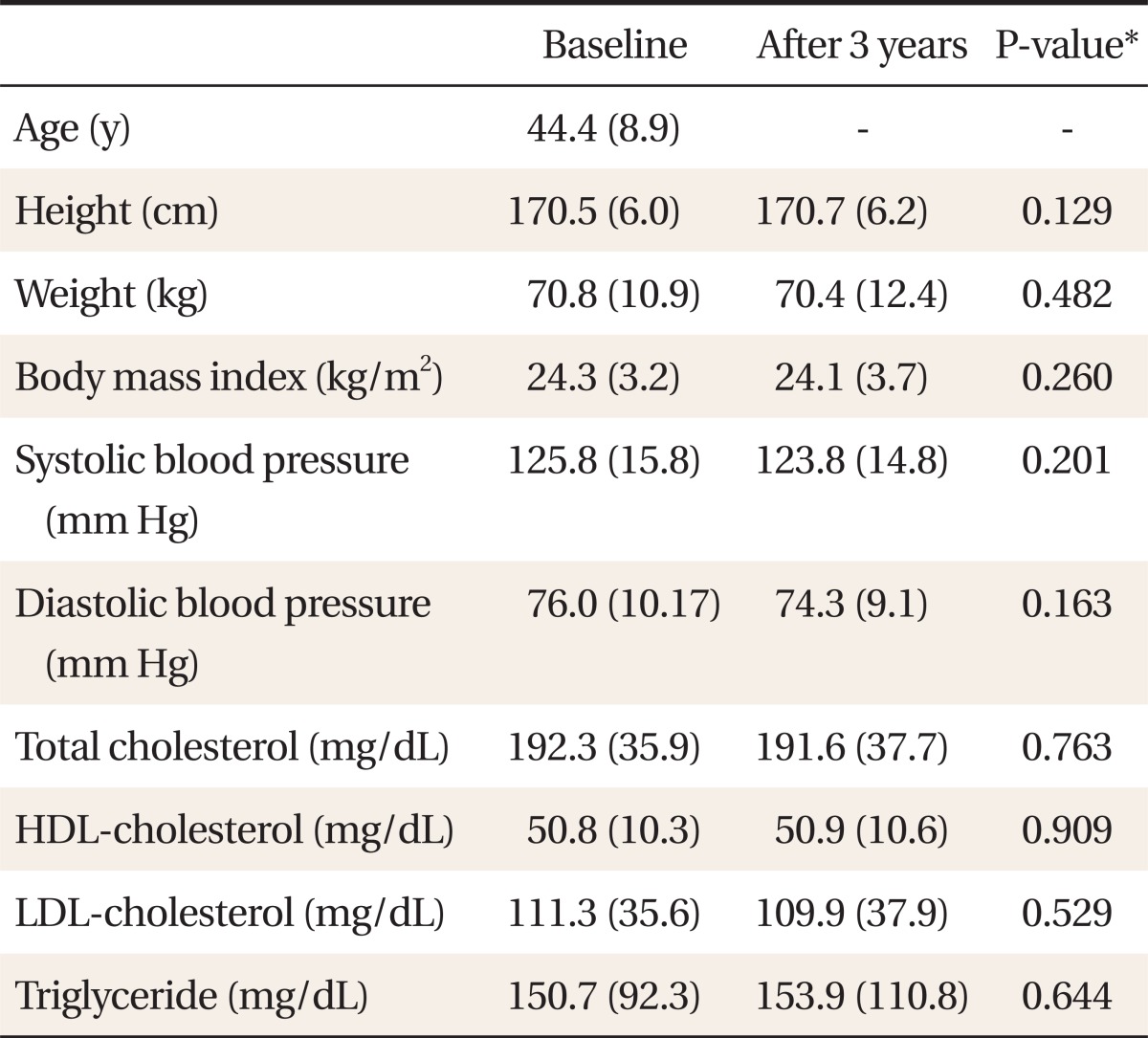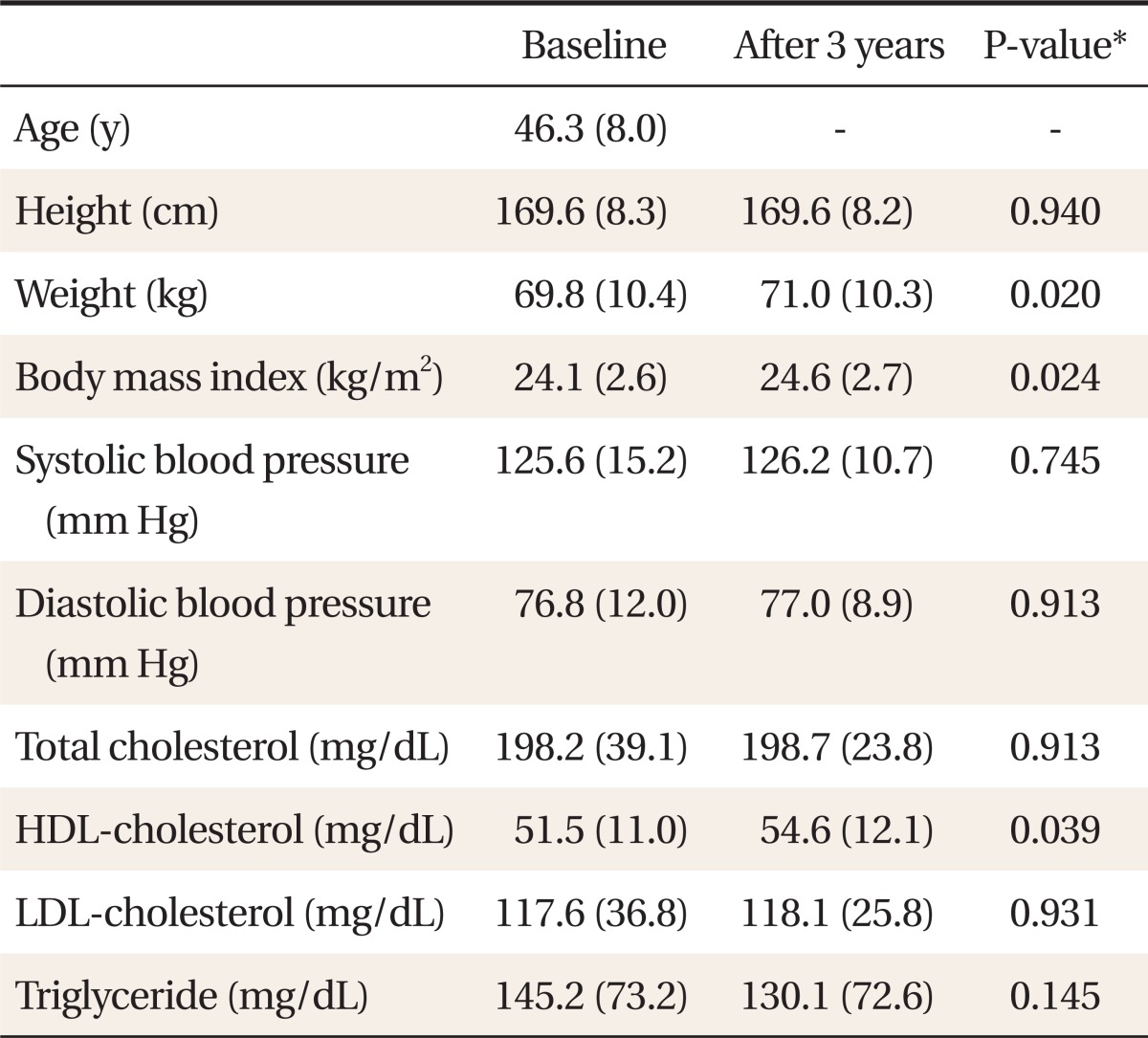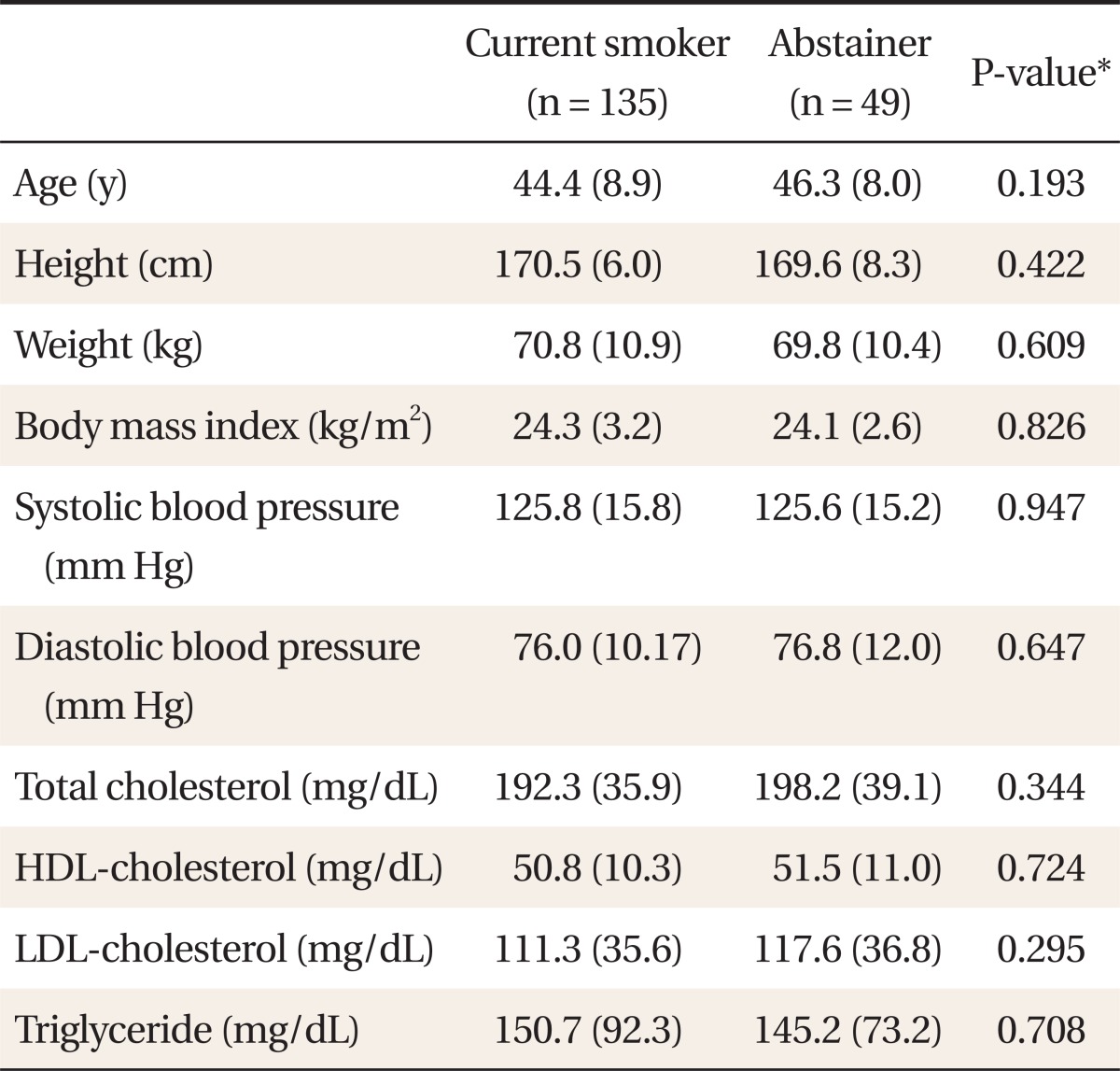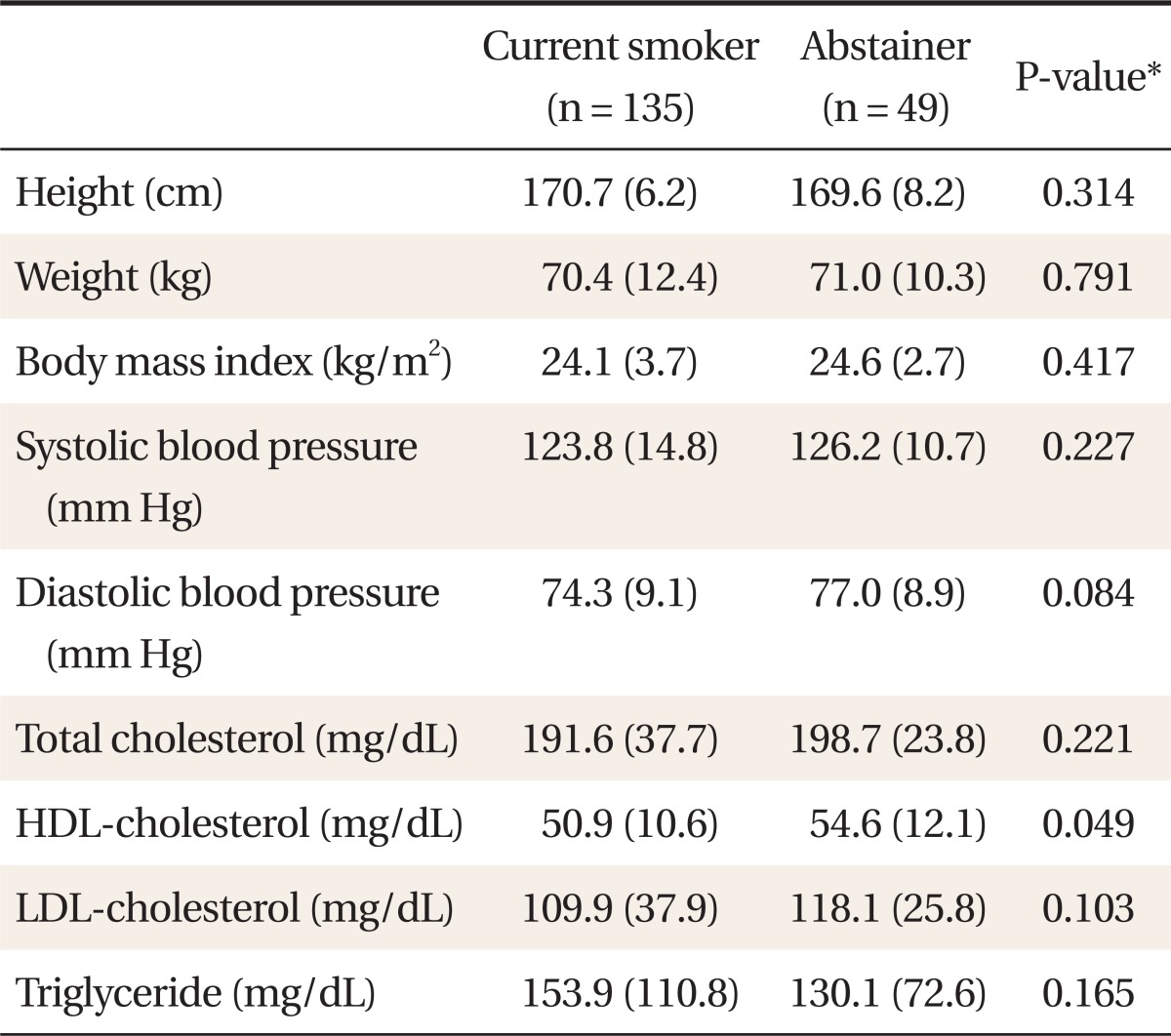 |
 |
- Search
| Korean J Fam Med > Volume 33(5); 2012 > Article |
Abstract
Background
Smoking and obesity are known risk factors for cardiovascular diseases, while low serum levels of high density lipoprotein-cholesterol is an independent risk factor for mortality from ischemic heart diseases. This study examines changes in the serum level of high density lipoprotein-cholesterol depending on changes in the state of smoking and body mass index.
Methods
A survey and blood check-up were conducted on medical examination, along with acts of smoking among male adults of 25 years or older who visited the health promotion center of Daegu Medical Center from 2007 to 2010, and the results were analyzed. The subjects were divided into two different groups, current smokers and abstainers, and body mass index, total cholesterol, high density lipoprotein-cholesterol, low density lipoprotein-cholesterol, and triglycerides for three years were compared in both groups. Changes between the first and second visits in body mass index and lipid profiles of the two groups were compared to analyze changes after abstaining.
The smoking rates of Korean adult men are still high compared to those of advanced countries, and eating habits are also becoming westernized. Accordingly, smoking and obesity are recognized as important social issues. Smoking is a risk factor that directly contributes to coronary heart disease. It is known, for example, that 25% to 30% of deaths from ischemic heart disease are attributed to smoking.1)
Smoking causes intravascular adipolysis and dyslipidemia, which facilitate atherosclerosis, reduce serum levels of high density lipoprotein (HDL)-cholesterol, and increase total cholesterol, triglycerides, and lipid peroxide.2) HDL-cholesterol plays a role in controlling diseases related to the cardiovascular system. It also functions as a medium in reverse cholesterol transportation from peripheral systems such as vascular tracts, hinders oxidation of low density lipoprotein (LDL)-cholesterol, thus providing anti-inflammatory effects, and also prevents atherosclerosis through antioxidant and antithrombotic effects.3,4)
According to research on changes of HDL-cholesterol level, such factors as obesity, smoking, little physical movement, and little intake of alcohol, decrease HDL-cholesterol levels.5) Low HDL cholesterolemia is an independent risk factor for cardiovascular diseases, and it is becoming increasingly common among Korean men.6) In addition, although the extent of obesity in Korea is not serious compared to that in Western countries, the morbidity of cardiovascular diseases is high and the risk factors for cardiovascular systems are increasing.7) The effect of smoking and obesity, therefore, is regarded as significant when it comes to low HDL cholesterolemia.
There have been various studies on the relation between smoking and obesity. One reported that smoking is related to a low body mass index (BMI) and that smoking cessation leads to weight gain8) while another reported that the average weight of smokers is heavier than that of non-smokers,9) which leaves the relation still uncertain. Thus, this study aims to examine changes in weight and serum level of HDL-cholesterol after smoking cessation.
The subject group include 779 men of 25 years of age or older who had health screening examinations twice in 2007 (1st) and three years later in 2010 (2nd) at the health promotion center of Daegu Medical Center. Information on general characteristics and history of smoking was collected through the survey. Those who did not state health-related behaviors such as smoking, or did not make it clear (307 individuals), were excluded. Non-smokers, former abstainers (273 individuals), those with diseases (cancer, diabetes, diseases of the thyroid gland, active tuberculosis, chronic illness, etc.) that might affect weight or lipid profile and those who were taking medications (15 individuals) were excluded. The number of final subjects was 184.
The subjects were classified as current smokers and abstainers according to their current state of smoking. Specifically, current smokers were smoking at the time of the first and second examinations, and abstainers had smoked at the time of the fist examination but tried to quit smoking and were no longer smoking at the time of the second examination.
The body weight of subjects was measured on a 0.1 kg scale with the examination gown on. Height was measured on a 0.1 cm scale by using an automatic height measuring system.
The subjects had a rest for 20 minutes and systolic blood pressure and diastolic blood pressure were measured at the right upper arm by an automatic pressure measuring device while they were sitting on a chair. In the case that the pressure was over 140/90 mm Hg, the pressures were measured again after a rest for 15 minutes.
To analyze the difference in results of the first and second examinations among the two groups (current smokers and abstainers), a paired t-test was implemented. To analyze the difference in the examination results between the current smokers and abstainers, an independent t-test was implemented. The subjects were divided into three groups depending on the measure of changes in the BMI, and an independent t-test was implemented to analyze changes in the concentration of HDL-cholesterol among the current smokers and abstainers. For the statistical analysis, SPSS ver. 19.0 (SPSS Inc., Chicago, IL, USA) was used and statistical significance was defined as a P-value < 0.05.
The 184 individuals selected as the final research subjects were 44.9 years of age on average (Table 1), and among them, the number of current smokers was 135 (73%), and that of abstainers 49 (27%), respectively. No significant difference was found in changes in the BMI, blood pressure, or serum lipid between the results of the first and second examinations in the current smokers group (Table 2). In contrast, such factors as weight, BMI, and HDL-cholesterol level in the abstainers group significantly increased in the second examination (P < 0.05). No significant change was found in other variables stated above (Table 3).
In the first examination, no significant difference was found between the current smokers and abstainers with regard to variables including the value of serum lipid. In the second examination, the HDL-cholesterol level of the abstainers was 54.6 mg/dL, which is significantly higher than the 50.9 mg/dL of the current smokers (P < 0.05) (Tables 4, 5).
As for changes in BMI (Δ, difference in the second and first examinations: kg/m2), the subjects were divided into three subgroups: the group of decrease (ΔBMI < -0.5), group of no change (-0.5 ≤ ΔBMI < 0.5), and group of increase (0.5 ≤ ΔBMI). In each group, changes in the HDL-cholesterol level were observed in both the current smokers and abstainers. However, only the group of abstainers who showed BMI decrease showed significant increase (P < 0.05) in the HDL-cholesterol level, while the other groups showed no significant difference (Table 6).
The aim of this study is to examine changes in such factors as weight, blood pressure, and serum lipid level after smoking cessation among men 25 years of age or older. Among the subjects, the abstainers showed significant increase in weight after three years, which is in line with the finding that the BMI significantly increases among non-smokers than smokers.10)
According to the research of FINRISK from 1982 to 1997, however, the BMI of smokers was lower than that of non-smokers in the early stage, but at the end of the 15-year-long investigation, no difference was found between smokers and non-smokers.11) Thus, the weight gain in the abstainers of this study could be controversial as to whether it is temporary or consistent.
Several cross-sectional studies reported that smoking is related to low HDL cholesterolemia,12) and that smoking cessation contributes to the increase of HDL-cholesterol.13) In this study as well, it turned out that the serum levels of HDL-cholesterol increased in the abstainers after three years. Although the relation between smoking and low HDL cholesterolemia has yet to be verified, some research stated that smoking facilitates the secretion of catecholamine and drastically increases free fatty acid, which leads to the increase of very low density lipoprotein and LDL-cholesterol and to the decrease of HDL-cholesterol at the same time.14)
According to one study, as the serum level of HDL-cholesterol increases as much as 1 mg/dL, the risk of coronary heart disease decreases as much as 2% to 3%.15,16) In this study, among abstainers, the serum level of HDL-cholesterol increased as much as 3 mg/dL, which is comparable to the case of those who kept smoking. Among abstainers whose BMI decreased as much as 0.5 kg/m2, the level of increase was 7 mg/dL on average.
While the weight and BMI increased in the abstainers, the serum level of HDL-cholesterol increased as well. Although there was a report that 1 kg of weight gain might reduce the serum level of HDL-cholesterol by as much as 0.5% to 1%,17,18) the effect of weight gain on HDL-cholesterol is considered to be counterbalanced by smoking cessation. Despite weight gain, the risk of cardiovascular system disease decreased in general when subjects stopped smoking. This could provide the basis on which to emphasize the importance of smoking among smokers who hesitate to quit smoking due to possible weight gain. This study shows that if the initiation of smoking cessation goes along with efforts to lose weight, the serum level of HDL-cholesterol could drastically increase.
The limitations of this study are as follows. First, since this is a retrospective study and a self-reported questionnaire was used, there is a possibility of error of recall. Furthermore, because the period of smoking cessation was not specifically presented, it is difficult to predict changes in the results as the term of smoking cessation extends. Second, such factors as level of alcohol intake, physical movement, or dietary pattern, which may affect the serum level of HDL-cholesterol and weight, were not considered in this study. Third, since domestic smoking rates among women were low, the subjects were limited to men. Since the subject group was small in number, the application to the general population may be limited. It is thought, however, that such disadvantages will be complemented by a prospective study in the future, conducted among the general population.
In conclusion, the combination of smoking cessation and weight control can increase the serum level of HDL-cholesterol more effectively, and thus prevent cardiovascular system diseases.
References
1. Marshall P. "Just one more...!" A study into the smoking attitudes and behaviour of patients following first myocardial infarction. Int J Nurs Stud 1990;27:375-387. PMID: 2081658.


2. Willett W, Hennekens CH, Castelli W, Rosner B, Evans D, Taylor J, et al. Effects of cigarette smoking on fasting triglyceride, total cholesterol, and HDL-cholesterol in women. Am Heart J 1983;105:417-421. PMID: 6829404.


3. Shah PK, Kaul S, Nilsson J, Cercek B. Exploiting the vascular protective effects of high-density lipoprotein and its apolipoproteins: an idea whose time for testing is coming, part I. Circulation 2001;104:2376-2383. PMID: 11696481.


4. Mackness MI, Arrol S, Abbott C, Durrington PN. Protection of low-density lipoprotein against oxidative modification by high-density lipoprotein associated paraoxonase. Atherosclerosis 1993;104:129-135. PMID: 8141836.


5. Kim SM, Han JH, Park HS. Prevalence of low HDL-cholesterol levels and associated factors among Koreans. Circ J 2006;70:820-826. PMID: 16799232.


6. Korea Centers for Disease Control and Prevention. The Third Korea National Health and Nutrition Examination Survey (KNHANES III), 2005. 2006. Cheongwon: Korea Centers for Disease Control and Prevention.
7. Yun YS, Park HS. Effect of body mass index change on cardiovascular risk factors in Korean men. J Korean Acad Fam Med 2002;23:794-803.
8. Lund Haheim L, Lund Larsen PG, Sogaard AJ, Holme I. Risk factors associated with body mass index increase in men at 28 years follow-up. QJM 2006;99:665-671. PMID: 16982635.


9. Molarius A, Seidell JC, Kuulasmaa K, Dobson AJ, Sans S. Smoking and relative body weight: an international perspective from the WHO MONICA Project. J Epidemiol Community Health 1997;51:252-260. PMID: 9229053.



10. Lee KY, Cho BM. The Association between body weight and hypertension according to smoking status in male workers. J Korean Acad Fam Med 2002;23:613-619.
11. Lahti-Koski M, Pietinen P, Heliovaara M, Vartiainen E. Associations of body mass index and obesity with physical activity, food choices, alcohol intake, and smoking in the 1982-1997 FINRISK Studies. Am J Clin Nutr 2002;75:809-817. PMID: 11976153.


12. Jansen DF, Nedeljkovic S, Feskens EJ, Ostojic MC, Grujic MZ, Bloemberg BP, et al. Coffee consumption, alcohol use, and cigarette smoking as determinants of serum total and HDL cholesterol in two Serbian cohorts of the Seven Countries Study. Arterioscler Thromb Vasc Biol 1995;15:1793-1797. PMID: 7583557.


13. Maeda K, Noguchi Y, Fukui T. The effects of cessation from cigarette smoking on the lipid and lipoprotein profiles: a meta-analysis. Prev Med 2003;37:283-290. PMID: 14507483.


14. Chelland Campbell S, Moffatt RJ, Stamford BA. Smoking and smoking cessation: the relationship between cardiovascular disease and lipoprotein metabolism: a review. Atherosclerosis 2008;201:225-235. PMID: 18565528.


15. Gordon DJ, Probstfield JL, Garrison RJ, Neaton JD, Castelli WP, Knoke JD, et al. High-density lipoprotein cholesterol and cardiovascular disease. Four prospective American studies. Circulation 1989;79:8-15. PMID: 2642759.


16. Grover SA, Kaouache M, Joseph L, Barter P, Davignon J. Evaluating the incremental benefits of raising high-density lipoprotein cholesterol levels during lipid therapy after adjustment for the reductions in other blood lipid levels. Arch Intern Med 2009;169:1775-1780. PMID: 19858435.


17. Dattilo AM, Kris-Etherton PM. Effects of weight reduction on blood lipids and lipoproteins: a meta-analysis. Am J Clin Nutr 1992;56:320-328. PMID: 1386186.


18. Hession M, Rolland C, Kulkarni U, Wise A, Broom J. Systematic review of randomized controlled trials of low-carbohydrate vs. low-fat/low-calorie diets in the management of obesity and its comorbidities. Obes Rev 2009;10:36-50. PMID: 18700873.


- TOOLS
-
METRICS

- Related articles in KJFM
-
Changes in Skin Color after Smoking Cessation2012 March;33(2)




